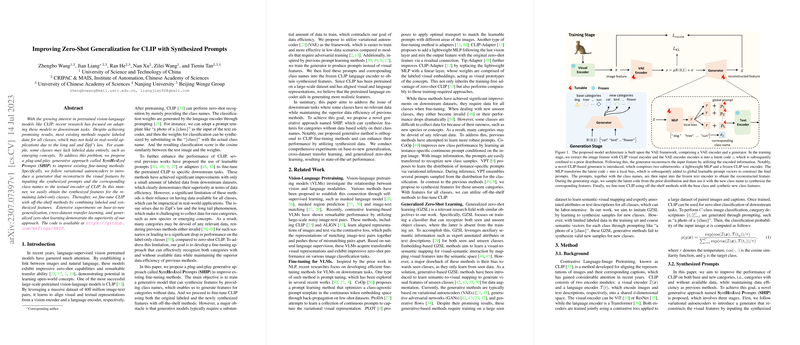Improving Zero-Shot Generalization for CLIP with Synthesized Prompts
The paper presents an innovative approach to enhance the zero-shot generalization capabilities of the CLIP model through synthesized prompts. Acknowledging the limitations posed by the need for labeled data in traditional fine-tuning methods, this paper introduces a novel generative approach, SyntHesIzed Prompts (SHIP), aimed at improving CLIP’s adaptability to emerging concepts and data-sparse classes adhering to Zipf's law.
Method and Approach
This paper leverages the architecture of Variational Autoencoders (VAE) to forge a generative model that synthesizes visual representations that correspond to textual prompts and class names fed into CLIP’s language encoder. This approach circumvents the need for vast labeled datasets, especially for classes without sufficient data representation.
The SHIP framework utilizes a VAE for generating prompts that align closely with the learned representations of CLIP. The generator component reconstructs visual features by utilising synthesized prompts within the language space, bolstering feature representation for classes that are predominantly label-only. To optimize data efficiency, the paper selectively chooses VAEs over adversarial networks for its generative needs, given their efficacy in scenarios with limited data.
The generated prompts incorporate both global learnable vectors and local biases, refined through lightweight MLP networks, maintaining synchronization with CLIP’s pretrained encoders. This synthesized data pool is then amalgamated with existing datasets, subsequently fine-tuned using established methods to enhance zero-shot recognition proficiency.
Results and Performance
The experimental evaluation through comprehensive tests including base-to-new generalization, cross-dataset transfer learning, and generalized zero-shot learning underscores the potency of SHIP. The work visibly demonstrates performance enhancements across multiple benchmarks, with notable improvements highlighted in visual recognition across traditionally challenging image datasets.
For instance, the proposed method raises the average accuracy and harmonic mean significantly compared to baseline models. SHIP’s integration with different established tuning methods shows versatility, yielding superior results across datasets like ImageNet and others, emphasizing efficacy over CoOp and CLIP-Adapter baselines.
Implications and Future Developments
The practical implications of this research highlight the potentially transformative impact of generative models in the zero-shot learning paradigm. By reducing reliance on labeled data, SHIP sets the stage for broadening AI's horizon in applications involving emergent concepts and underrepresented classes, essential for real-world scenarios depicting long-tailed distributions.
Theoretically, this proposes a shift in the vision-LLMing space, paving avenues for future explorations in fine-tuning methodologies leveraging synthetic data. Future research could explore streamlining the computational demands of SHIP, potentially investigating its application in more complex dense prediction tasks or its adaptability across distinct large-scale generative frameworks.
In conclusion, the paper contributes substantially to current understanding and methodologies in zero-shot learning, challenging traditional data-heavy paradigms while offering a feasible alternative solution through synthetic prompt generation. This approach not only addresses existing limitations but also opens up numerous prospects for further refinement and application in broader AI contexts.
